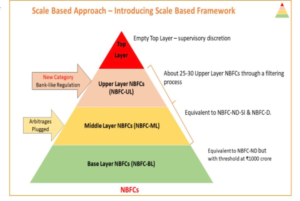NBFC is a company that provides loans, leases, insurance, and other financial services. It’s registered under the Companies Act, 1956.
There are two types of NBFCs based on their liability structure:
- Deposit-taking NBFCs (NBFC-D) accept deposits from customers and use that money to provide loans and other financial services.
- Non-deposit taking NBFCs (NBFC-ND) don’t accept deposits from customers but raise funds through other means, such as issuing bonds or borrowing from banks.
NBFC vs Bank:
NBFCs lend and make investments but are different from banks as:
- NBFC cannot accept demand deposits
- NBFCs do not form part of the payment and settlement system and cannot issue cheques drawn on themselves.
- The deposit insurance facility of Deposit Insurance and Credit Guarantee Corporation is not available to depositors of NBFCs, unlike in case of banks.
NBFC: Role
- NBFCs are complementary to the banking sector because they offer customer-oriented services, simplified procedures, attractive rates of return on deposits, flexibility, and timeliness in meeting the credit needs of specified sectors.
- According to the RBI’s Financial Stability Report, NBFCs have performed better than banks.
- NBFCs increase financial inclusion by providing services in areas where banks are not present.
- NBFCs are technologically advanced and make use of mobile phones and the internet to provide their services.
- NBFCs have a better understanding of their customers’ profiles at the ground level, which allows them to customize their products to meet the clients’ needs, thus deepening the financial markets.
NBFC: Challenges
- NBFCs are not required to maintain CRR and SLR, which can lead to defaults and bankruptcy. This can cause contagion in the market, break the trust of customers, result in the loss of savings, and lead to a liquidity crunch in the economy.
- There is a ticking financial bomb created by the nexus of NBFCs, credit rating agencies, and auditors. This can lead to false information about the creditworthiness of the NBFCs and put crores of investments at risk. For example, Infrastructure Leasing & Financial Services (IL&FS) scam.
- NBFCs can have an asset liability mismatch, which means they may not be able to meet their credit requirements.
- “Connected lending” is a practice in which NBFCs give loans to companies owned by their directors or their relatives, which can lead to financial scams.
NBFC: Regulatory Measures
- The special liquidity scheme involves creating an SPV that issues securities, which are then purchased by the RBI. The funds obtained from this scheme are then given to NBFCs to help with their liquidity needs.
- Targeted long term repo operations are a type of monetary policy used by the RBI to provide liquidity to the banking system, including NBFCs.
- Certain NBFCs are required to maintain 10% of their deposits in liquid assets to maintain liquidity.
- NBFCs that have net funds greater than Rs 50 lakhs are required to register with the RBI.
- NBFCs are required to submit periodical returns to the RBI on various matters relating to their operations. This helps the RBI to monitor and regulate NBFCs effectively.
NBFC: A way ahead
- The base layer consists of NBFC-ND with a threshold of 1000 crores, which are non-systemically important and have the least regulatory intervention.
- The middle layer consists of systemically important NBFCs and NBFC-D, which are subject to a stricter regulatory regime.
- The upper layer consists of Bank-like NBFCs that have a large potential for systemic spill-over of risks that could impact financial stability. These NBFCs are subject to a regulatory superstructure.
- The top layer is reserved for certain NBFCs in the upper layer that are deemed to pose extreme risks as per supervisory judgement. These NBFCs can be put in the top layer, which would subject them to even stricter regulation.





